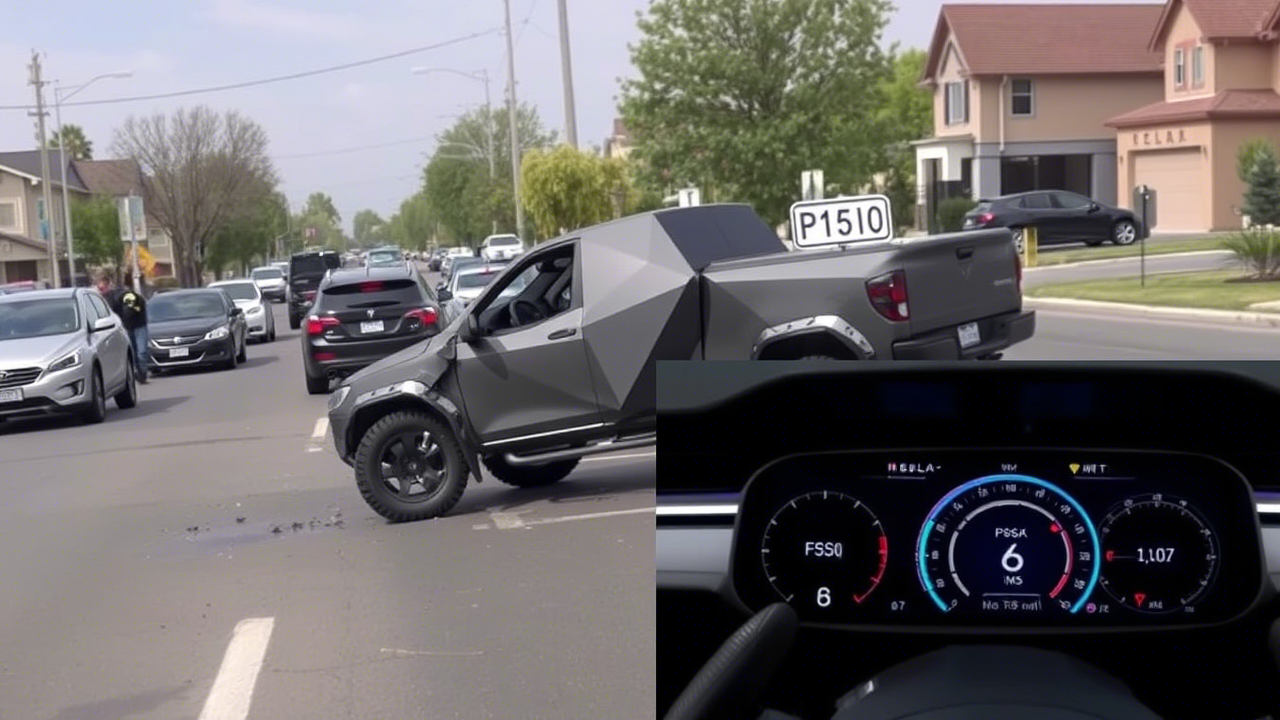In the world of electric vehicles (EVs) and autonomous driving, Tesla has always been a trailblazer. But when innovation meets real-world challenges, things can get messy—literally. Recently, a video of a Tesla Cybertruck crashing while operating on Full Self-Driving (FSD) version 13 went viral, sparking debates about the safety, reliability, and future of self-driving technology. In this article, we’ll break down what happened, analyze the implications, and explore expert opinions to help you understand why this incident is more than just another viral moment.
The Incident That Shook the EV Community
What Exactly Happened?
The crash occurred in broad daylight on a busy suburban street. According to eyewitness accounts and footage shared online, the Tesla Cybertruck was operating in FSD mode when it failed to recognize a stopped vehicle ahead. Instead of braking or swerving, the truck plowed straight into the back of the stationary car, causing significant damage to both vehicles.
Thankfully, no one was seriously injured, but the incident left many questioning whether Tesla’s FSD system was ready for public roads. The driver, who was reportedly monitoring the vehicle as required by law, claimed they didn’t have enough time to intervene.
Why Did This Go Viral?
Crashes involving Tesla vehicles are not uncommon, but this one stood out for several reasons:
- The Cybertruck Factor With its futuristic design and polarizing reputation, the Cybertruck is already a magnet for attention. Its involvement inn such an accident amplified public curiosity.
- FSD Version 13 wasn’t software—it was the latest iteration of Tesla’s much-hyped Full Self-Driving system, which Elon Musk himself has touted as a game-changer.
- Social Media Amplification: Within hours, the video spread across platforms like Twitter, Reddit, and YouTube, with millions of views and countless comments debating the merits (and risks) of autonomous driving.
Understanding TTesla’sFull Self-Driving Technology
How Does FSD Work?
Tesla’s Full Self-Driving system navigates roads without human input using a combination of cameras, radar, ultrasonic sensors, and neural networks. Unlike competitors that use LiDAR technology, Tesla bets heavily on computer vision—a bold move that has drawn both praise and criticism.
FSD v13 introduced improvements in object detection, lane recognition, and decision-making algorithms. However, even the most advanced AI systems aren’t foolproof. As experts point out, these technologies often falter in edge cases—rare scenarios that challenge the system’s logic.
Is FSD Really “Full Self-Driving”?
Despite its name, Tesla’s FSD doesn’t offer accurate Level 5 autonomy, where a vehicle can handle all driving tasks under any conditions without human oversight. Instead, it operates at Level 2 or 3, meaning drivers must remain alert and ready to take control at any moment.
This distinction is crucial because many consumers misunderstand FSD’s capabilities. A study by the Insurance Institute for Highway Safety (IIHS) found that over 40% of Tesla owners believe their cars can drive themselves ultimately—a dangerous misconception that could lead to accidents like the one involving the Cybertruck.
Expert Insights on Autonomous Driving Safety
The Role of Human Oversight
Dr. Emily Carter, a professor of robotics and AI ethics at Stanford University, explains, “Autonomous systems are tools designed to assist humans, not replace them entirely. When drivers rely too heavily on these systems, they become complacent, increasing the risk of errors.”
In the case of the Cybertruck crash, the driver may have assumed FSD would handle the situation, only to realize too late that intervention was necessary. This highlights the importance of proper training and clear communication from manufacturers about the limitations of their technology.
Regulatory Challenges Ahead
Regulators worldwide are grappling with how to oversee the deployment of self-driving cars. While Tesla pushes the boundaries of innovation, policymakers worry about ensuring public safety. For instance, the National Highway Traffic Safety Administration (NHTSA) recently launched an investigation into multiple Tesla crashes linked to FSD, citing concerns about potential design flaws.
As Dr. Michael Lee, a transportation policy analyst, notes, “We’re walking a tightrope between fostering technological advancement and protecting road users. Striking the right balance will require collaboration between automakers, regulators, and the public.”
Lessons Learned and Moving Forward
Addressing Public Concerns
Transparency is key for Tesla to regain trust after incidents like this. Sharing detailed data about how FSD processes information and responds to obstacles could reassure skeptical consumers. Additionally, investing in driver education programs might help bridge the gap between user expectations and reality.
Innovations on the Horizon
While setbacks like the Cybertruck crash grab headlines, they also drive progress. Engineers are likely analyzing every frame of the footage to identify weaknesses in the system and refine its algorithms. Future updates may include enhanced predictive modeling and better integration with traffic infrastructure, such as bright signals and connected vehicles.
The Bigger Picture
Beyond Tesla, this incident underscores broader questions about the role of AI in society. As machines take on more responsibilities traditionally handled by humans, ethical considerations become paramount. Who’s accountable when something goes wrong? How do we define acceptable levels of risk? These conversations will shape the evolution of autonomous driving for years to come.
Final Thoughts: Balancing Innovation and Responsibility
The Tesla Cybertruck crash on FSD v13 serves as a wake-up call for everyone invested in the future of mobility. While the promise of self-driving cars is undeniable—from reducing traffic congestion to minimizing human error—the journey there won’t be without bumps.
As consumers, we must stay informed and approach new technologies with a healthy dose of skepticism. As innovators, companies like Tesla are responsible for prioritizing safety above all else. Only then can we build a transportation ecosystem that’s not only cutting-edge but also trustworthy and inclusive.
So, the next time you see a headline about a self-driving car mishap, remember: it’s not just about the crash itself—it’s about what we choose to learn from it.








